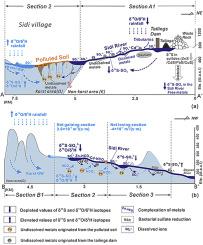Environmental Pollution ( IF 7.6 ) Pub Date : 2021-02-18 , DOI: 10.1016/j.envpol.2021.116774 Wenjing Qin , Dongmei Han , Xianfang Song , Shaohua Liu

|
Water quality is of great concern under the threats of an abandoned Pb–Zn mine within a vulnerable karst area. This study focuses on tracing the sources, migration and relevant geochemical controls of heavy metals along with surface- and groundwater flow, and assessing their hazards posed to the environment by indexes of heavy metal pollution (HPI) and ecological risks (ERI). We analyzed the concentrations of lead (Pb), zinc (Zn), cadmium (Cd) and copper (Cu) in filtered and digested surface water (SW) and groundwater (GW) samples. Whilst sulfate concentrations, δ34SSO4 isotope, and other physical-chemical parameters were measured in filtered SW and GW. Clearly elevated concentrations of Zn and Cd have been observed in the upstream of the Sidi River (max. 1540.3/1676.7, and 19.9/19.4 μg/L, for filtered/digested contents, respectively), and that of digested Pb and Cu (max. 17.8 and 114.6 μg/L, respectively) in the downstream karst groundwater. Zn and Cd are likely introduced by the Sidi River which is found mostly in the dissolved phase. While Pb and Cu are sourced from the remobilization of upper lying polluted soil which mostly existed in the particulate phase. Zn and Cd concentrations in the karst groundwater peak at the losing section while Pb and Cu in the river peaks at the gaining section as a result of metals transport with SW-GW exchange. Dilution significantly decreases total metals concentration in the non-karst area. Due to the buffer effect caused by carbonates dissolution and bacterial sulfate reduction, a steady neutral pH can reduce the concentrations of the dissolved metals in the karst area. The ERI and HPI assessments show an acceptable level for surface- and groundwater. A long-term observation on the contents of undissolved metals needs to be conducted in karst areas which are threatened by metal(s) mines.
中文翻译:

西南铅锌矿山的威胁下喀斯特水系统中重金属的来源和迁移
在脆弱的喀斯特地区内废弃的Pb-Zn矿山的威胁下,水质受到极大关注。这项研究的重点是追踪重金属的来源,迁移和相关的地球化学控制以及地表水和地下水的流量,并通过重金属污染指数(HPI)和生态风险(ERI)评估其对环境的危害。我们分析了经过过滤和消化的地表水(SW)和地下水(GW)样品中铅(Pb),锌(Zn),镉(Cd)和铜(Cu)的浓度。虽然硫酸盐浓度,δ 34小号SO4同位素和其他物理化学参数在经过过滤的SW和GW中进行测量。在西迪河上游,锌和镉的浓度明显升高(对于过滤/消化的含量,最高分别为1540.3 / 1676.7和19.9 / 19.4μg/ L),以及消化后的铅和铜(最高下游岩溶地下水中的浓度分别为17.8和114.6μg/ L。锌和镉很可能是由西迪河引入的,而西迪河主要存在于溶解相中。铅和铜来自上层被污染的土壤的迁移,这些土壤大部分存在于颗粒相中。由于通过SW-GW交换进行的金属运输,岩溶地下水中的Zn和Cd浓度在损失区达到峰值,而河流中的Pb和Cu在收益区达到峰值。稀释显着降低了非喀斯特地区的总金属浓度。由于碳酸盐溶解和细菌硫酸盐还原引起的缓冲作用,稳定的中性pH值可以降低岩溶区中溶解金属的浓度。ERI和HPI评估显示地表水和地下水的可接受水平。需要在受金属矿山威胁的喀斯特地区对未溶解金属的含量进行长期观察。











































 京公网安备 11010802027423号
京公网安备 11010802027423号